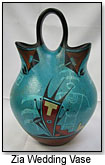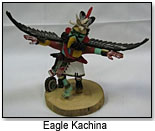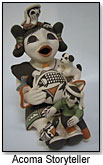| “Selling high-end collectible pieces is easier than you may think.” — Guy Berger, Palms Trading Company |
Before Guy Berger purchased the Palms Trading Company from his uncle Angelo Del Frate in 1988, his background in Native American arts and collectibles was limited. But after visiting Pueblo and Hopi villages, he learned about the people and the value of their work. This historic Albuquerque landmark, built in 1919, had been a grocery store, meat market and beer garden. It acted as a trading post where the Pueblo Indians pawned their handmade jewelry and crafts for necessities.
Today, this building has become a refined gallery of gifts, and its roots are no longer visible. Berger, author of "Pueblo and Navajo Contemporary Pottery,” a reference source for gift shop owners and appraisers, now houses one the most extensive selections of Native American artwork in the country.
Every day artists still come to sell their work, and Berger purchases from traders in other areas of New Mexico and Arizona. Estates and auctions are other sources, along with customers who bring in pieces they no longer want. His most popular items are jewelry and pottery. Everything he sells is guaranteed authentic.
Since the passage of the Native American Arts and Crafts Act of 1990, it has been illegal to market fake Native American goods.
"I believe it benefits our business tremendously because of our efforts to sell honestly," Berger told TDmonthly Magazine. "It does us no good in the long term to try to be dishonest with our merchandise."
By teaching buyers what to look for when selecting an item, Berger has found that the sophistication of the collector has gone to a higher level in knowledge and discrimination. He keeps his entire stock on the floor. With no back room accumulating merchandise, customers can see everything in a wide price range.
"Selling high-end collectible pieces is easier than you may think," he explained. "The piece speaks for itself because of the time and skill contained within. More than likely the artist is well known, or in our opinion, will soon be. The buyer then realizes the value and will buy the piece with very little cajoling."
Most buyers of expensive collectibles are repeat customers. Ninety percent are walk-ins and a mere 10 percent are requests, a fact that may surprise entrepreneurs who believe the only way to sell the upscale items is by special order. Berger says the number of walk-ins is high because of his huge selection.
As the gift and collectible industry continues to grow, the ability to market effectively will make or break a storeowner. Berger places strong emphasis on his Web site and the Internet for contacts, requests and sending digital photos. Sales via his site have increased. "I find, though, that in our business, people want to see, touch and feel the items we sell. Over time, as customers get to know and trust us, I see the e-business becoming a larger part of what we do."
The Palms clientele has been built primarily through word-of-mouth, and Berger now reaches an international community. He uses traditional methods of advertising such as a mailing list and an Indian Art Update newsletter every four months. A personal shopper program enables customers to receive notification when a requested item is acquired.
"Twice a year we produce a Palms Personal Shopping DVD that is sent to people that have requested it," Berger said. "This is a special presentation to our best collectors and gives them an up-close-and-personal show."
His plans for the future include expanding his mailing list and getting more publicity. "I want to make it easier for our customers to see and experience the magic of southwest art."

